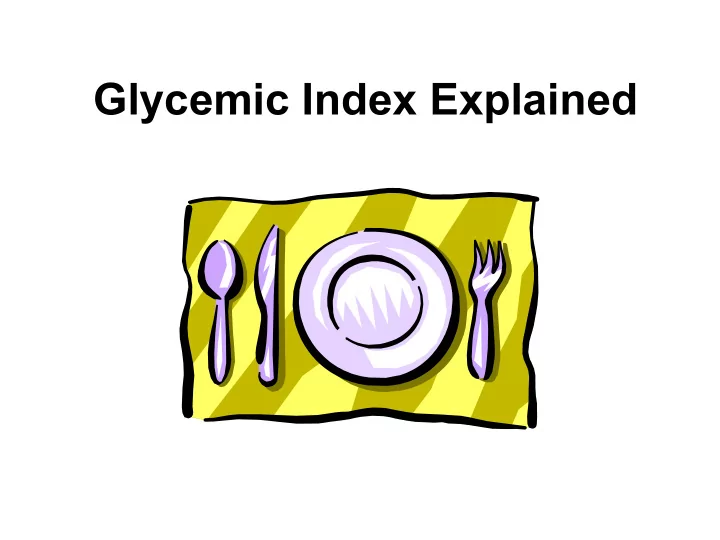

Glycemic Index Explained
Co - authors: Anne Garrett RD, BASc, MEd, CDE and Alison Phillmore, RD, CDE Reviewed by: Canadian Diabetes Association Nutrition Guidelines Implementation Subcommittee Correspondence to: Alison Phillmore William Osler Health Centre - Brampton Campus Diabetes Education Centre 905-796-4070 ext. 25667 alison_phillmore@oslerhc.org Updated: April 2003
Let’s discuss... • Glycemic Index – What does it mean? – Factors that influence the glycemic index rating – Factors that influence our body’s glycemic response • Possible benefits to health • What to eat!
The Glycemic Index (GI) � A scale that ranks carbohydrate- rich foods by how much they raise blood glucose levels compared to a standard food.
White Bread or Glucose Lentils (Standard) Blood Glucose Levels 1 hour 2 hours 1 hour 2 hours
Factors Influencing the Glycemic Index Rating
Factors Influencing GI Rating • Type of starch • Cooking • Food processing • Fat content of the food • Acid content of the food
Type of Starch Amylose vs. Amylopectin Amylose Amylopectin •Molecules form •Molecules are tight clumps more open •Harder to digest •Easier to digest Lower GI Rating Higher GI Rating
Cooking • Cooking can increase the GI rating of a food • Cooking swells starch molecules and softens foods making it faster to digest spaghetti, white – Boiled 5 min: GI = 34 – Boiled 10 – 15 min: GI = 40
Processing • Highly processed foods are digested faster and tend to have a higher GI rating Cornflakes GI = 86 Porridge (rolled oats) GI = 49
Processing • For unprocessed grains the GI rating is lower because it takes longer to digest the food pumpernickel bread GI = 46 white bread GI = 73
Fat in Foods • Foods with higher fat content have lower GI ratings. Fat content changes how your body digests foods. • This shows that Low GI foods are not always the healthiest choice! Potato chips GI = 75 Baked potato GI = 93
Acid in Foods • Acids present in foods slow down your body digesting that food. Slower digestion means slower rise in blood glucose. sourdough breads
Factors Influencing the glycemic response • Speed of stomach emptying – fat and protein • Mixed meals
Speed of stomach emptying: Fat and Protein • Fat and protein slow the rate of stomach emptying • Foods are digested at a slower rate • Lower glycemic response
Eating foods with a low GI may help to • Control blood glucose levels • Control cholesterol levels • Control appetite • Decrease risk of heart disease • Decrease risk of type 2 diabetes
What Should I Eat? Remember : Using the GI is only one part of healthy eating. Follow Canada’s Food Guide when making food choices for overall good health! Eat at regular times Limit sugar and sweets Decrease fat intake Include high fibre foods Limit salt, alcohol and caffeine
Tips to include low GI foods 1. Enjoy vegetables, fruits and low fat milk with your meals. 2. Choose one low GI food per meal 3. Plan menus around low GI food choices like lentils, barley and couscous. 4. Exchange high GI breads and cereals for lower GI alternatives
Glycemic Index Lower GI Foods Higher GI Foods Raise your blood Raise your blood glucose slower and glucose faster and lower. higher. Choose more often. Choose less often. Lower GI ideas Higher GI foods All Bran (42) Cornflakes (84) Bran Buds with psyllium (42) Branflakes (74) Oatmeal (42 to 66) Rice Krispies (82) Oat Bran (50) Cheerios (74)
The Glycemic Index Lower GI ideas Higher GI foods Pasta cooked “al dente” Canned or overcooked (32-64) spaghetti Whole grain pumpernickel (46) White bread (71-77) Rice: basmati or brown or Instant rice (87) long grain or parboiled (48-56) Short grain rice(72) Barley (25) Bulgar (48) Buckwheat (54) Chana dal (8)
The Glycemic Index Lower GI ideas Higher GI foods Popcorn (55) Pretzels (89) Soda crackers (74) Boiled new potatoes (56) French fries (75) Baked potato (93) Pear (38) Plums (39) Peach (42) Watermelon (72) Milk (42) Yogurt (30 to 40)
LUNCH: Sandwich on whole grain bread Yogurt on fresh peach slices OR Sandwich on white bun Doughnut
Questions
Recommend
More recommend